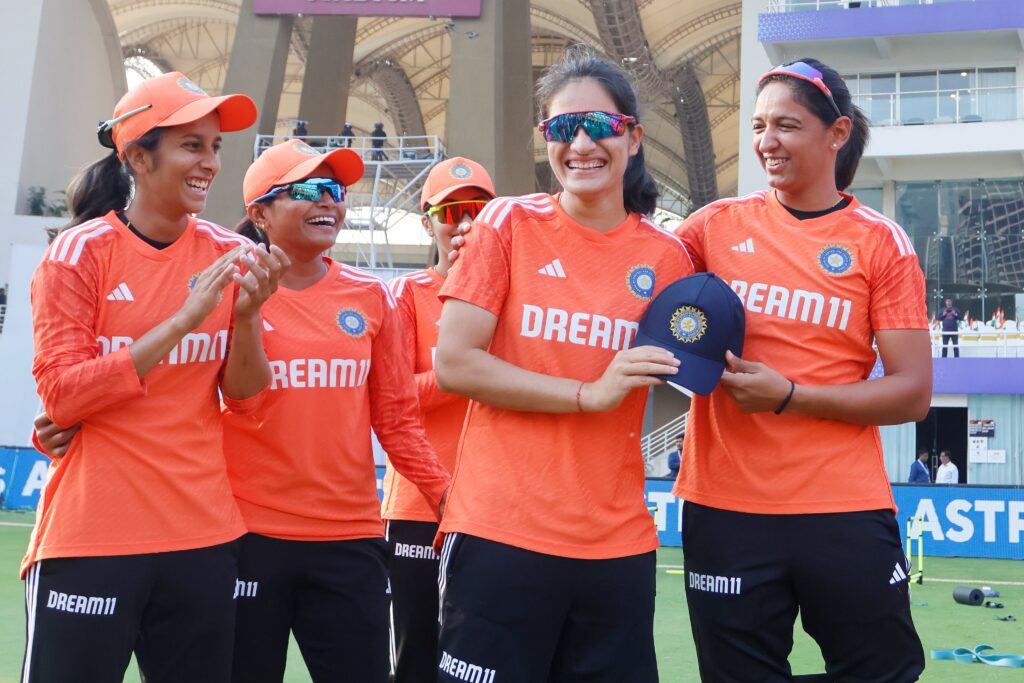
Written by Trisha Ghosal, stats by Snehasis Mukherjee
In the corridors of Indian women’s Test cricket history, the echoes of resilience and passion resonate from the inaugural days of 1976. As the women donned the whites, a new chapter unfolded, and over the years, the narrative has been woven through 38 Test matches. Among these battles, none have been as frequent and compelling as the clashes against England.
The journey of Indian women’s Test cricket has been a tale of perseverance and progress. Since the inception of this format, the team has faced various challenges, carving out a space for themselves on the international stage. In 2021, the last Test series witnessed Indian women locking horns with both Australia and England, with both encounters culminating in hard-fought draws. These stalemates, while not decisive, showcased the team’s mettle and determination.
Digging into the statistics reveals the heartbeat of this cricketing saga. Sandhya Agarwal’s bat has sung its own melody, amassing 1110 runs at an impressive average of 50.45, etching her name among the stalwarts. The bowling prowess, personified by Diana Edulji, with 63 wickets at an average of 25.77, has been instrumental in the team’s performances.
In the captaincy realm, Mithali Raj emerges as a beacon. Despite leading the team on only eight occasions, her 37% winning percentage makes her the most successful Test captain, a testament to her strategic acumen on the field.
However, it’s the encounters against England that add layers to this narrative. In 14 Test matches, the teams have engaged in battles marked by resilience and determination. Eleven of these contests stand testament to the parity between the sides, ending in draws. India’s triumphs, secured in Taunton in 2006 and Wormsley in 2014, are notable for being away victories, underscoring the team’s ability to conquer foreign territories. Conversely, England’s solitary win, etched in the records of 1995, was achieved on Indian soil in Jamshedpur.
Diving into the riveting anecdotes of the previous Test matches between India and England, one can’t overlook the records etched in the cricketing scrolls. The highest team total of 467 in Taunton in 2002, Mithali Raj’s monumental 214 during the same series, Jhulan Goswami’s sensational 10/78 at Taunton in 2006, and Neetu David’s masterful 8/53 in Jamshedpur in 1995 narrate a saga of individual brilliance and team resilience.
Rewinding to 2014, a year etched with debutante brilliance, India faced England with an audacious eight newcomers. Niranjana Nagarajan, a debutant, left an indelible mark with both bat and ball, while another newcomer, Smriti Mandhana, alongside the experienced Mithali Raj, ensured that triumph adorned the Indian camp. It was a tale of bold beginnings, a testament to the unpredictability that makes Test cricket a theatre of surprises.
Fast forward to today, the script unfolds once more. England, a team seasoned by the rigours of the Women’s Ashes, marches into Mumbai with the grandeur of their 100th Test match, a centenary of cricketing battles. In contrast, India women, having played a mere 38 Tests, find themselves navigating the intricacies of experience versus enthusiasm.
The narrative takes an interesting twist with the leadership mantle. Harmanpreet Kaur, with only three Tests under her belt, shoulders the responsibility of captaining the side. In the opposing camp, Heather Knight, with six Test matches as captain, brings a wealth of experience to the leadership role. The stage is set for a clash not just of skills but of leadership acumen.
The real challenge, however, lies beyond the numbers. Transitioning from the frenetic pace of T20Is to the patient, strategic rhythm of Test cricket demands more than just technical prowess. It requires a mental recalibration, a shift from quickfire decisions to the art of sustained concentration over days. This, perhaps, is the hurdle that looms larger than the inexperience on paper.
Yet, amid these challenges, there’s a sense of gratitude and optimism. The fact that Test matches are happening, that the whites are being donned, is a cause for celebration. In a cricketing world often dominated by shorter formats, the beauty and tradition of Test cricket needs champions, and these women stepping onto the field are becoming just that.
As the excitement builds for the ongoing match against England and the anticipation grows for the upcoming clash against Australia, there’s a collective hope for more of these contests. The statistics paint a story of battles waged on foreign soil and historic victories, but the dream is to witness more such encounters on home turf.
https://twitter.com/BCCIWomen/status/1735479791686427083
For a cricket aficionado, the prospect of women’s Test cricket gracing the hallowed grounds of Eden Gardens is a dream that echoes with the nostalgia of the sport’s rich history. The roar of the crowd, the red seats witnessing every twist and turn, and the legacy of cricketing legends – it’s a dream that transcends statistics and resonates with the pure, unadulterated love for the game.
In conclusion, as we cheer for the India women in the ongoing Test match against England and look forward to the clash with Australia, the desire for more Test matches for women reverberates. Each ball bowled, each run scored, and each wicket taken adds another layer to the narrative of women’s Test cricket. The dream of watching these battles unfold at iconic venues is not just a personal wish but a collective aspiration for cricket lovers worldwide. Here’s to the dream, the hope, and the continued growth of women’s Test cricket.
For more sports news click here



